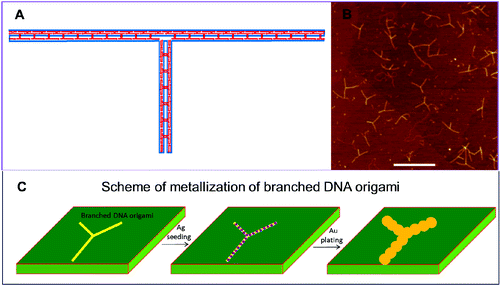| A simple and robust method for creating a wide variety of shapes and patterns, DNA origami can accommodate the increased complexity and flexibility needed for both the design and assembly of useful circuit templates. The next enabling step for circuit fabrication is the selective metallization of DNA origami templates in order to provide the conductive pathways for integrated nanoelectronics. Liu and colleagues provide improved understanding of and possible solutions to several key challenges for the metallization of DNA origami templates for nanoelectronic device fabrication. |
Reviewed by Jeff Morse, Ph.D, National Nanomanufacturing Network
- Liu J, Geng Y, Pound E, Gyawali S, Ashton JR, Hickey J, Woolley AT, and Harb JN. 2011. Metallization of Branched DNA Origami for Nanoelectronic Circuit Fabrication. ACS Nano Article ASAP 16 February 2011. DOI: 10.1021/nn1035075.
As integrated circuit fabrication processes face inherent limitations for increased circuit speed and density, transformative approaches combining top-down and bottom-up fabrication techniques are broadly being investigated. Some methods exploit the benefits of self-assembly processes to form controlled nanostructures, such as directed self-assembly, which has been included on the ITRS roadmap and has the potential to impact next generation nanoelectronic circuits.
DNA origami provides another alternative approach to fabricating transistor templates. A simple and robust method for creating a wide variety of shapes and patterns, DNA origami can accommodate the increased complexity and flexibility needed for both the design and assembly of useful circuit templates. It has been demonstrated that DNA origami can be reproduced in size and shape, as well as positioned and oriented on lithographically patterned substrates. The next enabling step for circuit fabrication is the selective metallization of DNA origami templates in order to provide the conductive pathways for integrated nanoelectronics. While metallization of a range of single-stranded DNA structures has been demonstrated, DNA origami presents numerous challenges in comparison due to the instability of the folded DNA structure that is held together by several short DNA strands and may be prone to unfolding during the metallization process sequence.

The described methods potentially provide the basis for increasingly complex templates for next generation nanoelectronics. The authors have reported a facile, solution-based process to stabilize DNA origami templates on a surface, and selectively metalize the templates. This represents an enabling approach to extend the synthesis of DNA origami towards future nanolectronic and sensor device technology.
Image reproduced with permission from Liu J ACS Nano Article ASAP 16 February 2011. DOI: 10.1021/nn1035075. Copyright 2011 American Chemical Society.
This work is licensed under a Creative Commons Attribution-NonCommercial 3.0 Unported.
